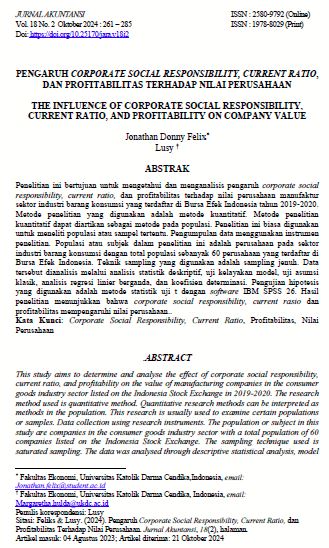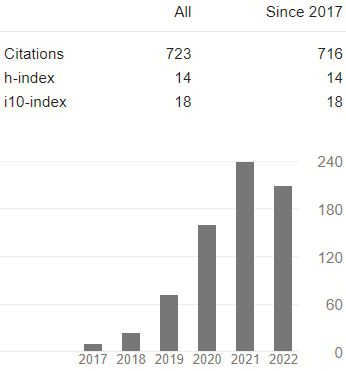THE INFLUENCE OF CORPORATE SOCIAL RESPONSIBILITY, CURRENT RATIO, AND PROFITABILITY ON COMPANY VALUE
DOI:
https://doi.org/10.25170/jak.v18i2.4639Keywords:
Corporate Social Responsibility, Current Ratio, ProfitabilityAbstract
This study aims to determine and analyse the effect of corporate social responsibility, current ratio, and profitability on the value of manufacturing companies in the consumer goods industry sector listed on the Indonesia Stock Exchange in 2019-2020. The research method used is quantitative method. Quantitative research methods can be interpreted as methods in the population. This research is usually used to examine certain populations or samples. Data collection using research instruments. The population or subject in this study are companies in the consumer goods industry sector with a total population of 60 companies listed on the Indonesia Stock Exchange. The sampling technique used is saturated sampling. The data was analysed through descriptive statistical analysis, model feasibility test, classical assumption test, multiple linear regression analysis, and coefficient of determination. Hypothesis testing used is the t test statistical method with IBM SPSS 26 software. The results showed that corporate social responsibility, current ratio and profitability affect firm value.
References
Adawiyah, N. R., & Setiyawati, H. (2019). The Effect of Current Ratio, Return on Equity, and Firm Size on Stock Return (Study of Manufacturing Sector Food and Baverage in Indonesia Stock Exchange). Scholars Bulletin, 05(09), 513–520. https://doi.org/10.36348/sb.2019.v05i09.004
Akisik, O., & Gal, G. (2017). The Impact of Corporate Social Responsibility and Internal Controls on Stakeholders’ View of the Firm And Financial Performance. Sustainability Accounting, Management and Policy Journal, 8(3), 246–280. https://doi.org/10.1108/SAMPJ-06-2015-0044
Ali, H. Y., Danish, R. Q., & Asrar-ul-Haq, M. (2020). How Corporate Social Responsibility Boosts Firm Financial Performance: The Mediating Role of Corporate Image and Customer Satisfaction. Corporate Social Responsibility and Environmental Management, 27(1), 166–177. https://doi.org/10.1002/csr.1781
Ananda, N. A. (2016). Pengaruh Profitabilitas, Growth Opportunity terhadap Nilai Perusahaan dengan Struktur Modal sebagai Variabel Intervening pada Perusahaan Property, Real Estate & Building Construction di BEI Periode 2011 – 2014. Jmm Unram - Master of Management Journal, 5(4), 1–18. https://doi.org/10.29303/jmm.v5i4.3
Annisa, R., & Chabachib, M. (2020). Analisis Pengaruh Current Ratio (CR), Debt to Equity Ratio (DER), Return on Assets (ROA) terhadap Price to Book Value (PBV), dengan Dividend Payout Ratio sebagai Variabel Intervening (Studi Kasus pada Perusahaan Industri Manufaktur yang Terdaftar di BEI). Diponegoro Journal of Management, 6(1), 188–202. https://ejournal3.undip.ac.id/index.php/djom/article/view/17551
Azhar, S., Seftiansyah, M. D., Agung, T., & Sugito, P. (2022). Analisis Penerapan Tax Planning dengan Menggunakan Metode Gross Up sebagai Efisiensi Pajak Penghasilan Badan pada Koperasi Pegawai Telkom. 4(6), 2130–2136.
D’Amato, A., & Falivena, C. (2020). Corporate Social Responsibility and Firm Value: Do Firm Size and Age Matter? Empirical Evidence from European Listed Companies. Corporate Social Responsibility and Environmental Management, 27(2), 909–924. https://doi.org/10.1002/csr.1855
Devina, M. S., & Purnama, M. (2022). Analisis Pengaruh Current Ratio, Return on Asset, Debt Ratio, dan Inventory Turnover terhadap Nilai Perusahaan pada Perusahaan Sektor Property and Real Estate yang Terdaftar di Bursa Efek Indonesia Periode Tahun 2016-2020. NIKAMABI : Jurnal Ekonomi & Bisnis, 1(2), 1–6.
Fasya, A. (2019). Pengaruh Pengungkapan Corporate Social Responsibility terhadap Nilai Perusahaan dengan Profitabilitas sebagai Variabel Pemoderasi. Jurnal Informasi, Perpajakan, Akuntansi, dan Keuangan Publik, 13(2), 145–162. https://doi.org/10.25105/jipak.v13i2.5012
Ghaderi, Z., Mirzapour, M., Henderson, J. C., & Richardson, S. (2019). Corporate Social Responsibility and Hotel Performance: A View from Tehran, Iran. Tourism Management Perspectives, 29(May 2018), 41–47. https://doi.org/10.1016/j.tmp.2018.10.007
Ghozali, I. (2016). Aplikasi Analisis Multivariate dengan Program IBM SPSS 23. Badan Penerbit Universitas Diponegoro.
Gunartin. (2017). Analisis Perkembangan Forum Corporate Social Responsibility di Jawa Timur. EDUKA: Jurnal Pendidikan, Hukum, dan Bisnis, 2(1), 49–59. http://openjournal.unpam.ac.id/index.php/Eduka/article/view/3755/2888
Guo, L., & Xu, L. (2021). The Effects of Digital Transformation on Firm Performance: Evidence from China’s Manufacturing Sector. Sustainability (Switzerland), 13(22), 1–18. https://doi.org/10.3390/su132212844
Gupta, A., Briscoe, F., & Hambrick, D. C. (2017). Red, Blue, and Purple Firms: Organizational Political Ideology and Corporate Social Responsibility. In Strategic Management Journal (Vol. 38, Issue 5). https://doi.org/10.1002/smj.2550
Hamdani. (2016). Good Corporate Governance: Tinjauan Etika dalam Praktik Bisnis (Pertama). Mitra Wacana Media.
Husnan, S., & Pudjiastuti, E. (2015). Dasar-dasar Manajemen Keuangan (Ketujuh). Unit Penerbit dan Percetakan (UPP STIM YKPN).
Husnan, S., & Pudjiasuti, E. (2018). Dasar-dasar Manajemen Keuangan (Ketujuh). Unit Penerbit dan Percetakan (UPP STIM YKPN).
Jamali, D., & Karam, C. (2018). Corporate Social Responsibility in Developing Countries as an Emerging Field of Study. International Journal of Management Reviews, 20(1), 32–61. https://doi.org/10.1111/ijmr.12112
Kasmir. (2018). Analisis Laporan Keuangan (Kasmir (ed.); 11th ed.). Raja Grafindo Persada.
Khan, H. ur R., Ali, M., Olya, H. G. T., Zulqarnain, M., & Khan, Z. R. (2018). Transformational Leadership, Corporate Social Responsibility, Organizational Innovation, and Organizational Performance: Symmetrical and Asymmetrical Analytical Approaches. Corporate Social Responsibility and Environmental Management, 25(6), 1270–1283. https://doi.org/10.1002/csr.1637
Kim, J. (Sunny), Song, H. J., Lee, C. K., & Lee, J. Y. (2017). The Impact of Four CSR Dimensions on a Gaming Company’s Image and Customers’ Revisit Intentions. International Journal of Hospitality Management, 61, 73–81. https://doi.org/10.1016/j.ijhm.2016.11.005
Kuzey, C., Uyar, A., Nizaeva, M., & Karaman, A. S. (2021). CSR Performance and Firm Performance in the Tourism, Healthcare, and Financial Sectors: Do Metrics and CSR Committees Matter? Journal of Cleaner Production, 319(July), 128802. https://doi.org/10.1016/j.jclepro.2021.128802
Lee, C. K., (Sunny) Kim, J., & Kim, J. S. (2018). Impact of a Gaming Company’s CSR on Residents’ Perceived Benefits, Quality of Life, and Support. Tourism Management, 64, 281–290. https://doi.org/10.1016/j.tourman.2017.09.002
Luque, A., & Herrero-García, N. (2019). How Corporate Social (ir)Responsibility in the Textile Sector is Defined, and Its Impact on Ethical Sustainability: An Analysis of 133 Concepts. Corporate Social Responsibility and Environmental Management, 26(6), 1285–1306. https://doi.org/10.1002/csr.1747
Lusy. (2020). Pengaruh Good Corporate Governance, Intellectual Capital, dan Corporate Social Responsibility terhadap Kinerja Keuangan dan Nilai Perusahaan. Doktoral Sekolah Tinggi Ilmu Ekonomi (STIESIA) Surabaya.
Lusy, Budiyanto, & Riduwan, A. (2020). Financial Performance and Value of SOEs: Seen from Good Corporate Governance, Intellectual Capital, and Corporate Social Responsibility. International Journal of Economics and Management Studies, 7(1), 9–17. https://doi.org/10.14445/23939125/ijems-v7i1p102
Luu, T., Viet, L., Masli, E., & Rajendran, D. (2019). Corporate Social Responsibility, Ambidextrous Leadership, and Service Excellence. Marketing Intelligence and Planning, 37(5), 580–594. https://doi.org/10.1108/MIP-05-2018-0157
Mardikanto, T. (2018). CSR Corporate Social Responsibility, Tanggung Jawab Sosial Korporasi. Alfabeta.
Martinez-Conesa, I., Soto-Acosta, P., & Palacios-Manzano, M. (2017). Corporate Social Responsibility and Its Effect on Innovation and Firm Performance: An Empirical Research in SMEs. Journal of Cleaner Production, 142, 2374–2383. https://doi.org/10.1016/j.jclepro.2016.11.038
Saha, R., Shashi, Cerchione, R., Singh, R., & Dahiya, R. (2020). Effect of Ethical Leadership and Corporate Social Responsibility on Firm Performance: A Systematic Review. Corporate Social Responsibility and Environmental Management, 27(2), 409–429. https://doi.org/10.1002/csr.1824
Said, L. (2018). Corporate Social Responsibility dalam Perspektif Governance (Pertama). Deepublish.
Salainti, M. L. I. (2020). Pengaruh Current Ratio, Total Asset Turnover dan Debt to Equity Ratio dan Return on Asset terhadap Nilai Perusahaan. Jurnal Ilmu dan Riset Manajemen, 8(10), 1–23.
Sartono, A. (2014). Manajemen Keuangan Teori dan Aplikasi, Cetakan keempat. BPFE.
Sondakh, R. (2019). The Effect of Dividend Policy, Liquidity, Profitability and Firm Size on Firm Value in Financial Service Sector Industries Listed in Indonesia Stock Exchange 2015-2018 Period. Accountability, 8(2), 91. https://doi.org/10.32400/ja.24760.8.2.2019.91-101
Soundararajan, V., Jamali, D., & Spence, L. J. (2018). Small Business Social Responsibility: A Critical Multilevel Review, Synthesis and Research Agenda. International Journal of Management Reviews, 20(4), 934–956. https://doi.org/10.1111/ijmr.12171
Stacia, E., & Juniarti. (2015). Pengaruh Pengungkapan Corporate Social Responsibility terhadap Nilai Perusahaan di Sektor Pertambangan. Bussiness Accounting Review, 3(1), 81–90.
Sugiyono. (2021). Metode Penelitian Kuantitatif Kualitatif dan R & D (Kedua). Alfabeta.
Supia, M., Aprilia, S., Sembiring, N., Sekali, L., & Aruan, D. (2021). Pengaruh Current Ratio, Intensitas Modal, dan Net Profit Margin terhadap Nilai Perusahaan Manufaktur yang Terdaftar di Bursa Efek Indonesia Periode 2017-2019. JIMEA: Jurnal Ilmiah MEA (Manajemen, Ekonomi, dan Akuntansi, 5(2), 499–515.
Susila, M. P., & Prena, G. Das. (2019). Pengaruh Keputusan Pendanaan, Kebijakan Deviden, Profitabilitas dan Corporate Social Responsibility terhadap Nilai Perusahaan. Jurnal Akuntansi : Kajian Ilmiah Akuntansi (JAK), 6(1), 80. https://doi.org/10.30656/jak.v6i1.941
Suwardika, I. N., & Mustanda, I. K. (2017). Pengaruh Leverage, Ukuran Perusahaan, Pertumbuhan Perusahaan, dan Profitabilitas terhadap Nilai Perusahaan pada Perusahaan Properti. E-Jurnal Manajemen Unud, 6(3), 1248–1277.
Tetrault Sirsly, C. A., & Lvina, E. (2019). From Doing Good to Looking Even Better: The Dynamics of CSR and Reputation. Business and Society, 58(6), 1234–1266. https://doi.org/10.1177/0007650315627996
Vo, D. H., & Nguyen, T. M. (2014). The Impact of Corporate Governance on Firm Performance: Empirical Study in Vietnam. International Journal of Economics and Finance, 6(6), 1–13. https://doi.org/10.5539/ijef.v6n6p1
Weygandt, J., Kimmel, P., & Kieso, D. (2013). Financial Accounting (Third). John Wiley.
Yoon, B., & Chung, Y. (2018). The Effects of Corporate Social Responsibility on Firm Performance: A Stakeholder Approach. Journal of Hospitality and Tourism Management, 37(November), 89–96. https://doi.org/10.1016/j.jhtm.2018.10.005

Downloads
Published
Issue
Section
License
Copyright (c) 2024 Lusy, Jonathan Donny Felix

This work is licensed under a Creative Commons Attribution-ShareAlike 4.0 International License.
Authors who publish with this journal agree to the following terms:
- Authors retain copyright and grant the journal right of first publication with the work simultaneously licensed under a Creative Commons Attribution-ShareAlike 4.0 International License that allows others to share the work with an acknowledgment of the work's authorship and initial publication in this journal.
- Authors are able to enter into separate, additional contractual arrangements for the non-exclusive distribution of the journal's published version of the work (e.g., post it to an institutional repository or publish it in a book), with an acknowledgment of its initial publication in this journal.
- Authors are permitted and encouraged to post their work online (e.g., in institutional repositories or on their website) prior to and during the submission process, as it can lead to productive exchanges, as well as earlier and greater citation of published work.














